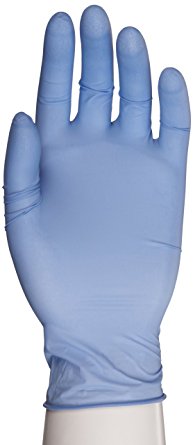- Enter your model number to make sure this fits.
- Nitrile provides better elasticity than vinyl, better puncture resistance than latex or vinyl, and better abrasion resistance than chloroprene
- Textured along the length of the fingers for improved grip compared to a glove with textured fingertips, and the non-stick surface helps prevent tape and adhesives from sticking to the glove
- Palm thickness is 3.5 mils and finger thickness is 5.1 mils, and standard length glove is 9.6″ long and has a beaded wrist cuff that is 2.8 mils thick
- Chlorinated glove allows for quick donning, particularly in wet environments, compared to a non-chlorinated glove
- Powder-free glove leaves no residue, helping to reduce the likelihood of spreading bacteria compared to a powdered glove
The Microflex FreeForm SE disposable, chlorinated, powder-free, standard length nitrile glove has textured fingers. It has a palm thickness of 3.5 mils and a finger thickness of 5.1 mils, and is 9.6″ long from the tip of the middle finger to the edge of the beaded wrist cuff, which is 2.8 mils thick. It is suitable for dental, emergency medical services, healthcare, industrial safety, and laboratory applications. Nitrile provides better elasticity than vinyl, better puncture resistance than latex or vinyl, better abrasion resistance than chloroprene, and helps reduce the likelihood of allergic reaction. The glove is textured along the length of the fingers for improved grip compared to a glove with textured fingertips. A non-stick surface helps prevent tape and adhesive from sticking to the glove. It has been washed in a diluted chlorine-based solution to help reduce tackiness, providing lower surface friction than a non-chlorinated glove and allowing quick donning in wet environments. This powder-free glove leaves no residue, helping to reduce the likelihood of spreading bacteria compared to a powdered glove. The color of this ambidextrous glove is blue.
Tensile strength, measured in megapascals (MPa), is the amount of force required to rip a glove; the higher the number, the stronger the glove material. This glove has a tensile strength of 32 MPa before aging and 31 MPa after aging. Elongation measures how much a glove can be stretched before it breaks. It is expressed as a percent of the original length of the glove at the moment of breakage, and the higher the percent, the more the glove can stretch. This glove has an elongation of 500% before aging and 400% after aging. Acceptable Quality Level (AQL) is a Food and Drug Administration (FDA) quality specification for the defect rate in surgical and exam gloves. The FDA requires an AQL of 1.5 for surgical gloves and 2.5 for exam gloves. This glove has an AQL of 1.5, which means the defect level from a large sample of the gloves will not exceed 1.5%. Microflex examination gloves meet or exceed applicable standards imposed by ASTM International, formerly known as the American Society for Testing and Materials (ASTM), and the FDA.
Disposable and limited-use gloves are used in medical, forensic, scientific, art, and industrial applications. Gloves are commonly made from flexible materials such as latex, nitrile, chloroprene, and vinyl. While most disposable gloves are designed for either hand, some can be purchased in hand-specific models. They are offered powdered or powder-free; silicone or silicone-free; chlorinated or non-chlorinated; coated or uncoated; with a standard- or extended-length cuff; sterile or non-sterile; and with textured or smooth fingers, fingertips, and palms. A glove’s abrasion, cut, and puncture resistance is defined by glove material and thickness, and may be improved with the use of certain exterior coatings. Abrasion resistance means the glove helps protect the hand from contact with rough objects. Cut resistance means the glove helps protect the hand from blades and sharp instruments. Puncture resistance means the glove helps protect the hand from pointed objects such as pins and needles. Chemical resistance means the glove helps protect the hand from certain chemicals. Chemical resistance is defined by glove material, thickness, and length, as well as the work environment and chemicals likely to be encountered. For information on the chemical resistance of this glove, consult the manufacturer’s chemical resistance guide.
Microflex Corporation manufactures disposable gloves. The company, founded in 1988 and headquartered in Reno, NV, meets International Organization for Standardization (ISO) 13485:2003.

